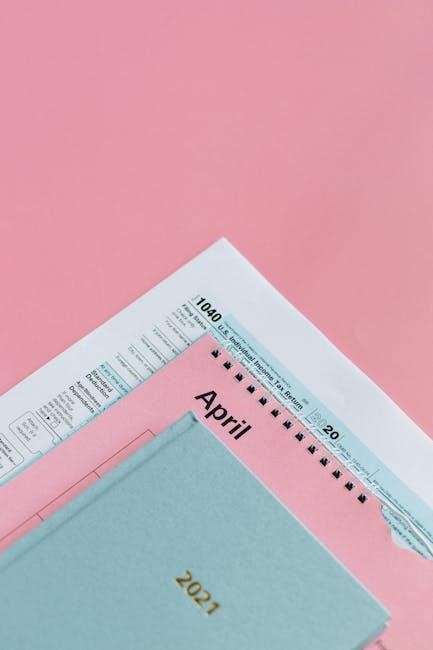The 12 Week Year Planner is a powerful time management system that helps you achieve more in 12 weeks than most people do in 12 months. It’s designed to boost productivity by focusing on high-impact actions and eliminating distractions.

This structured approach includes a downloadable PDF template with tools like a 12-week calendar, weekly scorecards, and daily planners. It’s perfect for breaking down annual goals into manageable, focused 12-week segments, ensuring clarity and accountability.
Understanding the 12 Week Year Concept
The 12 Week Year concept is a time management philosophy that challenges traditional annual planning by treating each 12-week period as a “year.” This approach emphasizes focus, accountability, and high-impact actions to achieve significant results in less time. By breaking down goals into shorter, manageable cycles, individuals can avoid procrastination and maintain consistent productivity.
The system is structured to help users identify and prioritize their most important objectives, ensuring alignment with their vision. It encourages a mindset shift from annualized thinking, which often leads to complacency, to a more immediate and actionable framework. Key tools like the 12 Week Year PDF planner provide templates for goal setting, weekly scorecards, and daily planners, enabling users to track progress effectively.
Central to this concept is the idea that every 12-week cycle represents a fresh opportunity to start anew, allowing for continuous improvement and learning. This structured yet flexible approach makes it easier to stay focused, execute plans, and achieve meaningful outcomes in a shorter timeframe.

What is a 12 Week Year Planner?
A 12 Week Year Planner is a time management tool designed to help users achieve their goals in 12 weeks. It includes a PDF with templates for goal setting, weekly planning, and daily tracking to maximize productivity.
Key Features of the 12 Week Year PDF
The 12 Week Year PDF is a comprehensive goal-setting tool offering structured templates for daily, weekly, and monthly planning. It includes a 12-week calendar to set initial goals, weekly scorecards to track progress, and a daily planner for task management.
Lead and lag indicators are incorporated to monitor productivity effectively. The PDF also provides a robust review section for reflecting on past performance, helping users learn and improve for the next cycle. Its simplicity and focus on actionable steps make it an essential resource for achieving success in just 12 weeks.
Additionally, the planner is customizable, allowing users to tailor it to their specific needs. Whether printed or used digitally, it serves as a versatile system to stay organized and motivated throughout the year.
Overall, the 12 Week Year PDF is a powerful system designed to help individuals execute their goals with clarity and focus, ensuring they make the most of their time and efforts.
How the 12 Week Year System Works
The 12 Week Year system operates by breaking down annual goals into focused 12-week segments, treating each period as a “year” to maximize productivity. This approach avoids the pitfalls of traditional annual planning, which often leads to procrastination and low productivity.
The system emphasizes identifying and prioritizing high-impact actions, eliminating distractions, and maintaining accountability. It uses a structured framework, including a 12-week calendar, weekly scorecards, and daily planners, to ensure consistent progress toward goals.
By focusing on measurable outcomes and tracking both lead and lag indicators, users can monitor their progress effectively. The system also incorporates a robust review process after each 12-week cycle, allowing for reflection, learning, and adjustment of strategies for the next cycle.
This structured yet flexible approach ensures that users stay aligned with their objectives, making meaningful progress in a shorter timeframe.

Benefits of Using a 12 Week Year Planner
The 12 Week Year Planner enhances productivity by focusing on high-impact tasks, ensuring accountability, and providing a clear structure for goal achievement, helping users accomplish more in less time effectively and stay focused.
Why the 12 Week Year System is Effective
The 12 Week Year system is effective because it avoids the pitfalls of annualized thinking, which often leads to procrastination and low productivity. By focusing on a shorter, 12-week cycle, individuals can concentrate on high-impact tasks that drive real results.
This system emphasizes accountability and clarity, helping users stay focused on their goals. The structured approach ensures that each week and day is intentional, eliminating distractions and fostering a sense of urgency.
Additionally, the system encourages regular reflection and adjustment, allowing for continuous improvement. The availability of PDF templates and tools makes it easy to plan and track progress, ensuring that users can execute their goals with precision and consistency.

How to Achieve More in 12 Weeks Than Others Do in 12 Months
Achieving more in 12 weeks than others do in 12 months is possible by focusing on high-impact tasks and eliminating distractions. The 12 Week Year system helps you prioritize what truly matters, ensuring every day and week is intentional and aligned with your goals.
By breaking down annual goals into manageable 12-week segments, you create clarity and accountability. This structured approach avoids the pitfalls of annualized thinking, where progress is often delayed or spread too thin. Instead, it fosters a sense of urgency and focus, driving consistent execution.
Regular tracking and reflection are key. Weekly scorecards and daily planners help monitor progress, while lead and lag indicators ensure you’re on track. This system not only accelerates results but also promotes continuous improvement, making it a powerful tool for achieving success in less time.

How to Create a 12 Week Year Plan
Start by identifying your main goal and breaking it into smaller, actionable steps. Use the 12 Week Year PDF templates to structure your plan, including weekly scorecards and daily trackers. This ensures clarity, accountability, and consistent progress toward your objectives.
Setting Your Goals for the 12 Week Year
Setting clear and actionable goals is the foundation of the 12 Week Year system. Start by identifying your main objective, ensuring it aligns with your vision and is specific, measurable, and achievable within 12 weeks. Break this goal into smaller, manageable weekly and daily tasks using the 12 Week Year Planner PDF templates. These templates include goal-setting action sheets and mind mapping tools to help you structure your plan effectively.
Focus on high-impact activities that drive progress toward your goal, avoiding distractions. The 12 Week Year system emphasizes accountability, so track your performance regularly. Use the weekly scorecard and review process to stay on course and make adjustments as needed. By setting focused, structured goals, you’ll maximize productivity and ensure steady progress throughout the 12-week cycle.
Remember, the 12 Week Year Planner PDF provides a robust framework to guide you in setting and achieving your goals. With its step-by-step approach, you’ll be able to create a clear roadmap for success and maintain the discipline required to execute your plan effectively.
Breaking Down Your Goals into Weekly and Daily Tasks
Breaking down your goals into weekly and daily tasks is essential for achieving success in the 12 Week Year system. Start by identifying your main objective and then divide it into smaller, actionable steps that align with your 12-week timeline. Use the 12 Week Year Planner PDF to create a weekly calendar, where each week is dedicated to specific tasks that move you closer to your goal.
Each week, outline the key activities and milestones you need to accomplish. Then, further break these down into daily tasks using the daily planner section of the PDF. This structured approach ensures that you stay focused and make consistent progress. The weekly scorecard and review process help you track your performance and make necessary adjustments to stay on course.
By breaking your goals into manageable weekly and daily tasks, you eliminate overwhelm and maintain momentum throughout the 12-week cycle. The 12 Week Year Planner PDF provides the tools and structure you need to stay organized and achieve your objectives effectively.

Tracking Progress and Measuring Success
Tracking progress and measuring success are crucial in the 12 Week Year Planner. Use lead and lag indicators to monitor your advancements and ensure alignment with your goals. Weekly scorekeeping helps maintain focus and drive consistent execution.
Using Lead and Lag Indicators to Monitor Your Progress
Monitoring progress with lead and lag indicators is essential for staying on track in your 12 Week Year Plan. Lead indicators are proactive measures that predict future results, such as the number of daily tasks completed or weekly meetings scheduled. Lag indicators, on the other hand, measure outcomes after the fact, like total sales closed or projects finished. By tracking these metrics, you can identify trends, make adjustments, and ensure alignment with your goals.

Regularly reviewing these indicators helps you stay accountable and focused. For example, if your lead indicators show consistent progress but your lag indicators aren’t meeting expectations, it may be time to refine your strategy. This dual approach ensures you’re not only working hard but also working smart, driving meaningful results in your 12-week cycle.
Using these indicators effectively allows you to celebrate small wins and address challenges early, keeping your momentum strong throughout the 12 weeks. This balanced approach to tracking progress is a cornerstone of the 12 Week Year system’s success.

Weekly Scorekeeping and Review
Weekly scorekeeping and review are critical components of the 12 Week Year system, ensuring you stay on track to meet your goals. Each week, you score your progress based on completed tasks and their alignment with your objectives. This process involves evaluating what worked well and identifying areas for improvement.
By conducting a weekly review, you can celebrate accomplishments, address setbacks, and adjust your plan as needed. This consistent reflection helps maintain focus and accountability, preventing small issues from becoming major obstacles. Additionally, it allows you to refine your strategy, ensuring each week builds momentum toward your 12-week goals.
Regular scorekeeping also fosters a sense of accountability, helping you stay committed to your objectives. Over time, this practice becomes a habit, enhancing your ability to execute effectively and achieve significant results within the 12-week timeframe.

